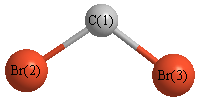Jump to
S2C1
Energy calculated at CISD/6-31G*
| | hartrees |
|---|
| Energy at 0K | -5177.848591 |
| Energy at 298.15K | -5177.853620 |
| HF Energy | -5177.523097 |
| Nuclear repulsion energy | 326.393115 |
The energy at 298.15K was derived from the energy at 0K
and an integrated heat capacity that used the calculated vibrational frequencies.
Geometric Data calculated at CISD/6-31G*
Point Group is C2v
Cartesians (Å)
| Atom |
x (Å) |
y (Å) |
z (Å) |
|---|
| C1 |
0.000 |
0.000 |
1.006 |
| Br2 |
0.000 |
1.550 |
-0.086 |
| Br3 |
0.000 |
-1.550 |
-0.086 |
Atom - Atom Distances (Å)
| |
C1 |
Br2 |
Br3 |
| C1 | | 1.8958 | 1.8958 |
Br2 | 1.8958 | | 3.0993 | Br3 | 1.8958 | 3.0993 | |
 More geometry information
More geometry information
Calculated Bond Angles
| atom1 |
atom2 |
atom3 |
angle |
|
atom1 |
atom2 |
atom3 |
angle |
| Br2 |
C1 |
Br3 |
109.656 |
|
Electronic energy levels
Charges, Dipole, Quadrupole and Polarizability
Jump to
S1C1
Energy calculated at CISD/6-31G*
| | hartrees |
|---|
| Energy at 0K | -5177.838317 |
| Energy at 298.15K | -5177.843359 |
| HF Energy | -5177.539391 |
| Nuclear repulsion energy | 316.312068 |
The energy at 298.15K was derived from the energy at 0K
and an integrated heat capacity that used the calculated vibrational frequencies.
Geometric Data calculated at CISD/6-31G*
Point Group is C2v
Cartesians (Å)
| Atom |
x (Å) |
y (Å) |
z (Å) |
|---|
| C1 |
0.000 |
0.000 |
0.751 |
| Br2 |
0.000 |
1.655 |
-0.064 |
| Br3 |
0.000 |
-1.655 |
-0.064 |
Atom - Atom Distances (Å)
| |
C1 |
Br2 |
Br3 |
| C1 | | 1.8451 | 1.8451 |
Br2 | 1.8451 | | 3.3099 | Br3 | 1.8451 | 3.3099 | |
 More geometry information
More geometry information
Electronic energy levels
Charges, Dipole, Quadrupole and Polarizability
